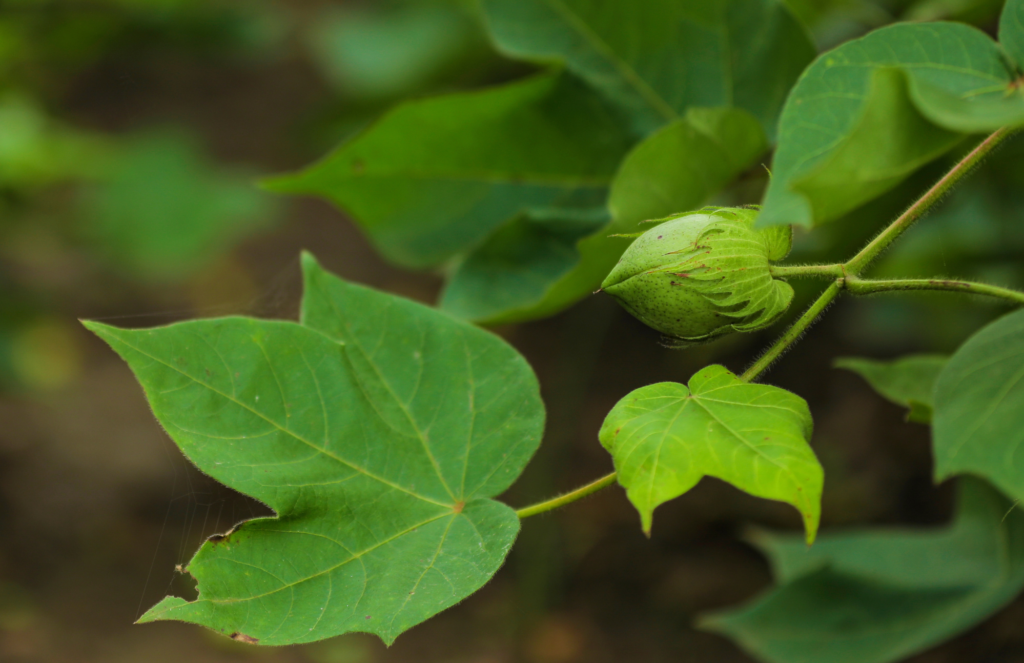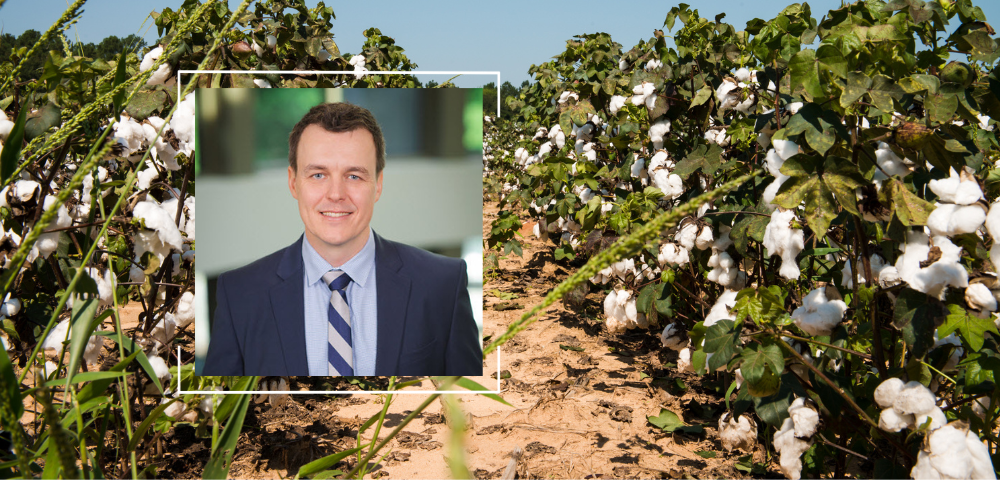
– Interview with Dr Jesse Daystar, Chief Sustainability Officer from Cotton Incorporated –
Climate change is affecting the cotton value chain increasingly. In this interview with the Bremen Cotton Report editorial team Dr Jesse Daystar, Chief Sustainability Officer from Cotton Incorporated, dives into various aspects of climate change and sustainability in cotton. The sustainability expert underlines the progress of cotton farmers in the recent years, explains the potential of regenerative agriculture and assesses the impact of upcoming sustainability legislation.
Bremen Cotton Report: How does the cultivation and processing of cotton contribute to or mitigate climate change impacts?
Jesse Daystar: The cultivation and processing of cotton have undergone continual improvement, as evidenced by a 25% reduction in greenhouse gas emissions per kilogram of cotton over the last 40 years in the US. These reductions stem from various factors including improved agricultural practices such as precision irrigation, reduced tillage, optimized fertilizer use, cover crops and crop rotation, as well as advances in technology and processing methods which have led to greater efficiency in cotton processing.
Beyond the agricultural phase, innovations in textile production such as the adoption of renewable energy sources and improvements in manufacturing efficiency also contribute to reducing the carbon footprint of cotton-based products.
Reflecting on the past 10 years, what notable advancements have been made regarding sustainability within the cotton industry?
Cotton farming practices worldwide have undergone significant transformations over time. Particularly in the United States, there has been a strong emphasis on innovation and continual enhancement, resulting in notable reductions in water, land, and energy requirements for cotton cultivation, as well as diminished soil erosion and greenhouse gas emissions. These improvements have been accompanied by an increase in crop yields.
Evidence spanning the last four decades demonstrates impressive accomplishments by U.S. cotton farmers. Noteworthy achievements include a remarkable 58% decrease in water usage, a 30.6% reduction in energy consumption, and a substantial 25% cut in greenhouse gas emissions.
Where do you see the main challenge when it comes to cotton sustainability in the consumer perception?
While awareness about sustainable cotton practices may vary, there‘s immense potential to educate stakeholders about the environmental and social benefits associated with sustainable cotton production. From growers to brands and retailers who source cotton to the people that buy and wear it, it is critical to ensure that all audiences have access to accurate information.
Committed to this cause, Cotton Incorporated has dedicated years of research to dispel prevalent myths surrounding cotton.
Moreover, as more brands and retailers embrace sustainability certifications and labels, consumers are provided with messages of credibility and assurance regarding the sustainability of their cotton choices. This transparency attempts to foster trust and empowers consumers to make informed decisions aligned with their values.
Despite challenges, there‘s a growing trend among consumers towards natural fibers and more sustainable purchasing behavior. Globally, 78 percent of consumers say they would prefer the clothing in their wardrobes be made of cotton (40 percent), denim (22 percent), or cotton blends (16 percent), according to the Cotton Council International and Cotton Incorporated’s 2023 Global Lifestyle Monitor™ Survey. By emphasizing the superior quality, longevity, and ethical sourcing of more sustainable cotton products, the industry can attract consumers who prioritize environmental and social responsibility.
What lies behind the trend of regenerative agriculture, and could it potentially be the key to transforming the cotton sector?
In recent years, regenerative agriculture has gained significant attention as a response to concerns about soil degradation, climate change, and the sustainability of conventional agriculture.
It’s important to understand the differences between sustainable and regenerative. Sustainability refers to practices that can be maintained over the long term without depleting resources or harming the environment. Regenerative practices go beyond sustainability by actively restoring, renewing, or revitalizing ecosystems and natural resources.
By adopting practices like crop rotation and conservation tillage, cotton growers can enhance the resilience of ecosystems and foster long-term agricultural productivity. Not only can these regenerative practices help to lower costs, but they also may increase net income, offering a win-win solution for both farmers and the environment in various locations.
While there‘s a significant opportunity for producers, adopting these practices can entail risks. Initiatives like the U.S. Cotton Trust Protocol’s Climate Smart Cotton Program are taking proactive steps to support the expansion of regenerative agriculture practices. These practices include the adoption of cover crops, reduced tillage, and nutrient management.

How do you consider the potential impact of recycling initiatives and circular economy concepts?
Yes, recycling initiatives and circular economy concepts could significantly contribute to sustainable cotton processing and a better environmental footprint for cotton. Cotton is inherently circular as it can be reused and recycled in various ways, and all parts of the cotton plant can be used.
Recycling technologies are constantly evolving, and recycled pre- and post-consumer cotton textiles can be used in a wide variety of nonwoven products, ranging from wet wipes, filters, and automotive applications to building and construction materials. Even parts of the cotton plant that would otherwise be considered waste can be used again to create biodegradable packaging and cotton gin waste used in the production of bio-synthetic sulfur dyes. Cotton composting is another option we’re exploring that involves decomposing cotton waste into nutrient-rich organic matter. By enriching the soil, compost improves its structure, enhances water retention, and increases nutrient content, resulting in healthier plants and higher crop yields. Additionally, composting diverts organic waste from landfills, reducing methane emissions and conserving precious landfill space. Additionally, this practice could play a crucial role in climate change mitigation by sequestering carbon in the soil.
Despite the promise of circularity and recycling, we all have to focus in on the cost to do such actions and how those cost relate to the product and also to the investments that could be made elsewhere that would yield better sustainability outcomes. Getting garment to garment textile recycling to scale will be technically and financially challenging. Further the environmental benefits are not always clear when compared to growing virgin cotton, especially using regenerative agriculture practices.
Considering the increasing efforts by countries and regions to regulate textile supply chains with a sustainability focus, how is this likely to affect the cotton supply chain?
The increasing focus on sustainability regulations could influence production costs and sourcing decisions.
An increased emphasis on traceability will come with an increased emphasis on country-level sustainability data. Over the past two years, Cotton Incorporated has worked closely with Cascale’s Higg Cotton Expert Methodology Group which worked with other cotton stakeholders to establish a common best practice to collect cotton production data, model this data for LCA (Life Cycle Assessment) and use this data to create systematic change throughout the supply chain. This transition towards country-level data and education of how to use LCAs will be critical towards making progress towards brand and global climate change reduction goals.
Furthermore, traceability and sustainability data will be required from cotton and cotton growers.
To address this, Cotton Incorporated collaborates closely with leading agricultural universities, offering financial support, technical guidance, and essential supplies to researchers dedicated to making these technologies more accessible to small farmers.
Thank you very much for the interview!
The interviews in the column “Question Time“ embody the opinion of the respective interview partner and do not represent the position of the Bremen Cotton Exchange as neutral, independent institution.

